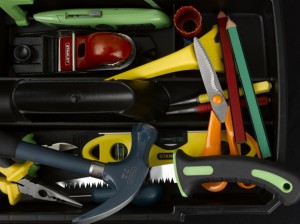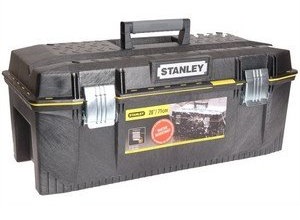The best toolbox
The best toolboxes for the DIY market, and the professional market for that matter, are supplied by Stanley. As a company, Stanley seem to have made it their mission to design the perfect toolbox range by carefully thinking through exactly what ‘we’ require, rather than just slapping a couple of hinges on a box, which is what many other manufacturers have clearly done. The following guide looks at the essentials for toolbox design, and which Stanley option is, in my opinion, the best toolbox in their range.
Toolbox strength
It doesn’t matter how many little compartments a toolbox has, or what colour it is, or what size it is, if it’s not strong enough to do the job, it’s not going to last very long. Thin, bendy, plastic toolbox options get easily distorted as soon as they are filled with tools, which generally makes it difficult to close the lid. Also, plastic latches or closing tabs tend to break, or come off once put under any sort of strain, so always opt for toolboxes with metal latches.
The other area of weakness revolves around the handle, which should always fold flat, flush, with the toolbox lid. This is pretty standard with most toolbox manufacturers these days, but some still have it standing proud, which means any time you stack something on top of the toolbox, and you generally do from time to time, you risk damaging the handle.
Size of toolbox

I like to fit as many tools as possible in my toolbox; it just saves you popping backwards and forwards to the shed all day.
With toolbox size, it’s a bit like buying a shed, wardrobe, or any other type of storage facility; basically you should always opt for something slightly larger than you think you need. Therefore I say ‘go large’, so you can fit the majority of all everyday tools inside it. For example, I like to keep a panel saw, cartridge gun, and 600 mm (2 ft) spirit level, inside the toolbox so that you don’t have them rattling around somewhere else in your shed, drawer or cupboard. Yes, this does mean that your toolbox becomes a rather heavy lump, but it also means that when you take your toolbox to work in a room or area in your home, you know you then have nearly all you need close to hand.
I really don’t buy into the ‘much easier to carry around’ argument for having a small, light toolbox, as I never intend to carry it around all day, and I’d rather do it once a day and have everything to hand, than constantly be dashing backwards and forwards to the shed, looking for yet another tool.
Toolbox design
You can still buy cantilever metal toolboxes, and I must admit, they do still have some sort of ‘classic’ attraction for me. However, I used them for many years, and finally, I just couldn’t stand the constant need to make sure that tools were sitting flat in their compartments, otherwise it became impossible to close the toolbox. So, now, I just think the big open box design, with a tray, is the simplest and best option. I’m not a fan of adding small compartments for fixings, within the lid, as too many times, I’ve either found that they don’t fasten down easily, break, or if you forget to fasten them correctly, you open your toolbox, and spray the contents of the lid compartments everywhere.
If you literally have a minimal DIY toolkit requirement, you may well opt for this design, as you can fit all your tools and fixings in one unit; otherwise, I’d recommend to keep your fixings in a separate storage box.
My toolbox choice

The Stanley Waterproof Toolbox – for me, the best option on the market!
For me the Stanley Waterproof toolbox fits the bill in every way. As well as having a huge cavernous interior, it also has a single three quarter length tray, perfect for keeping smaller items separate, and sorted. Because the tray isn’t the full length of the toolbox, it allows you to have bulky tools poking up at one end, and taking up the full height of the toolbox, if required; a simple feature, but it works well for me.
In terms of strength, it’s made of incredibly robust structural foam, the hinging system is strong, the latches are rust proof, and what’s more, the whole thing is waterproof. The groove in the lid comes in handy for ‘holding’ items when sawing and cutting, and furthermore, with the lid closed it makes a more than comfortable seat for when you’re having a cup of tea!
The Stanley Waterproof toolbox is available on Amazon, as well as with other suppliers such as Screwfix, and UK Tool Centre. They’re simply the best toolboxes you can buy; I’d go for the 28″ option, but if you prefer, there is also a 23″ option available.
